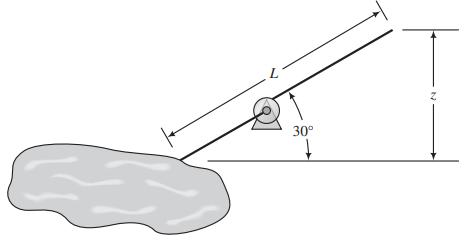Water is to be pumped from a lake to a ranger station on the side of a
Question:
Water is to be pumped from a lake to a ranger station on the side of a mountain (see figure). The length of pipe immersed in the lake is negligible compared to the length from the lake surface to the discharge point. The flow rate is to be 95 gal/min, and the flow channel is a standard 1-inch. Schedule 40 steel pipe (ID = 1.049 inch). A pump capable of delivering 8 hp (= Ẇs) is available. The friction loss F̂(ft•lbf /lbm) equals 0.041L, where L(ft) is the length of the pipe.
(a) Calculate the maximum elevation, z, of the ranger station above the lake if the pipe rises at an angle of 30°.
(b) Suppose the pipe inlet is immersed to a significantly greater depth below the surface of the lake, but it discharges at the elevation calculated in Part (a). The pressure at the pipe inlet would be greater than it was at the original immersion depth, which means that ΔP from inlet to outlet would be greater, which in turn suggests that a smaller pump would be sufficient to move the water to the same elevation. In fact, however, a larger pump would be needed. Explain (i) why the pressure at the inlet would be greater than in Part (a), and (ii) why a larger pump would be needed.

Step by Step Answer:

Elementary Principles of Chemical Processes
ISBN: 978-1119498759
4th edition
Authors: Richard M. Felder, Ronald W. Rousseau, Lisa G. Bullard




